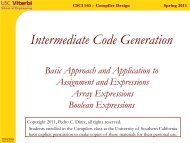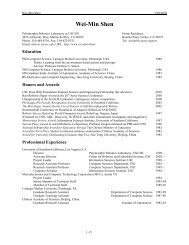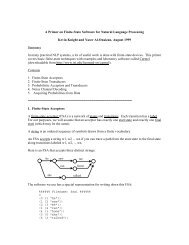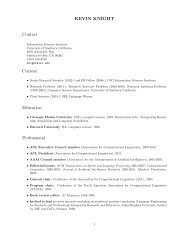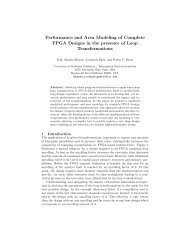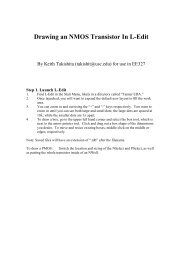Induction of Word and Phrase Alignments for Automatic Document ...
Induction of Word and Phrase Alignments for Automatic Document ...
Induction of Word and Phrase Alignments for Automatic Document ...
Create successful ePaper yourself
Turn your PDF publications into a flip-book with our unique Google optimized e-Paper software.
Computational Linguistics Volume 1, Number 1<br />
Connecting Point has become the single largest Mac retailer after tripling it ’s Macintosh sales since January 1989 .<br />
Connecting Point Systems tripled it ’s sales <strong>of</strong> Apple Macintosh systems since last January . It is now the single largest seller <strong>of</strong> Macintosh .<br />
- Jump to the first document word <strong>and</strong> choose a length <strong>of</strong> 3.<br />
- Generate the summary phrase “Connecting Point” based on the document phrase “Connecting<br />
Point Systems.”<br />
- Jump to a null state.<br />
- Generate the summary word “has” from null.<br />
- Generate the summary word “become” from null.<br />
- Jump our <strong>of</strong> “null” to the fourth document word <strong>and</strong> choose a length <strong>of</strong> 1.<br />
- Generate the summary phrase “tripling” given “tripled.”<br />
- Jump to the fifth document word <strong>and</strong> choose a length <strong>of</strong> 1.<br />
. . .<br />
- Jump to the thirteenth document word (“last”) <strong>and</strong> choose a length <strong>of</strong> 2.<br />
- Generate the summary phrase “January 1989” given “last January.”<br />
- Jump to a null state.<br />
- Generate the summary word “.” from null.<br />
- Jump out <strong>of</strong> null to the end <strong>of</strong> the document.<br />
Figure 3<br />
Beginning <strong>and</strong> end <strong>of</strong> the generative process that gave rise to the alignment in Figure 1, which is<br />
reproduced here <strong>for</strong> convenience.<br />
In Figure 3, we have shown a portion <strong>of</strong> the generative process that would give rise<br />
to the alignment in Figure 1.<br />
This generative story implicitly induces an alignment between the document <strong>and</strong><br />
the summary: the summary phrase is considered to be aligned to the document phrase<br />
that “generated” it. In order to make this computationally tractable, we must introduce<br />
some conditional independence assumptions. Specifically, we assume the following:<br />
1. Decision (a) in our generative story depends only on the position <strong>of</strong> the end <strong>of</strong><br />
the current document phrase (i.e., j + l).<br />
2. Decision (b) is conditionally independent <strong>of</strong> every other decision.<br />
3. Decision (c) depends only on the phrase at the current document position.<br />
3.2 Statistical model<br />
Based on the generative story <strong>and</strong> independence assumptions described above, we can<br />
model the entire summary generation process according to two distributions:<br />
• jump(j ′ | j + l), the probability <strong>of</strong> jumping to position j ′ in the document when<br />
the previous phrase ended at position j + l.<br />
• rewrite(s | dj:j+l), the “rewrite” probability <strong>of</strong> generating summary phrase s<br />
given that we are considering the sub-phrase <strong>of</strong> d beginning at position j <strong>and</strong><br />
ending at position j + l.<br />
Specific parameterizations <strong>of</strong> the distributions jump <strong>and</strong> rewrite will be discussed in<br />
Section 4 to enable the focus here to be on the more general problems <strong>of</strong> inference <strong>and</strong><br />
decoding in such a model. The model described by these independence assumptions<br />
8





